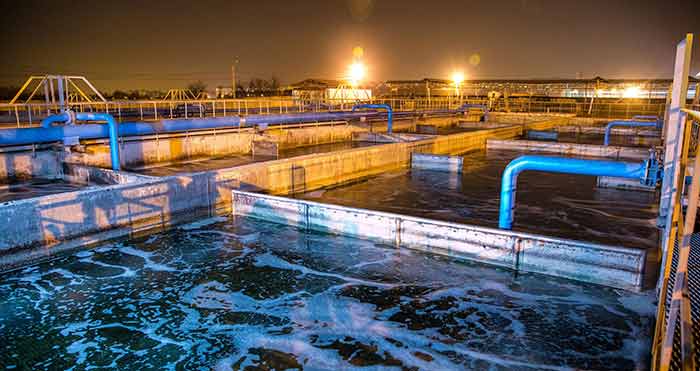Accurately measuring the flow of materials in a wastewater processing facility is required to meet both safety and regulatory standards, as is making sure the right combination of chemical cleaning additive is used. There are several flow meters and solutions available to do this. This article will examine the advantages and capabilities of magnetic flow meters for these applications. Magnetic flow meters—also known as mag meters—operate on the principle of Faraday’s Law of Electromagnetism. The more conductive a fluid is—impurities make water conductive—the better it will be reflected in the readings, which makes mag meters suited for wastewater applications. In broad terms, there are two types of wastewater treatment facilities: industrial and municipal. Both deal with wastewater in similar ways. In both situations, one will find:
- Primary treatment consists of temporarily holding sewage in an evaporation basin where heavy solids can settle to the bottom, while grease and lighter solids float to the surface and are skimmed off.
- Secondary treatment removes dissolved and suspended biological matter. This is usually completed through water-borne microorganisms in a managed habitat. This may require an additional separation process to remove the microorganisms prior to discharge or tertiary treatment.
- Tertiary treatment is the final stage where disinfectant chemicals may be added before the water is discharged into a stream, river, bay, lagoon or wetland. It may even be used for irrigation of golf courses or parks.
 Image 1. Wastewater treatment facilities measure solids, fine particles and gasses at each step of the process. (Image courtesy of Emerson)
Image 1. Wastewater treatment facilities measure solids, fine particles and gasses at each step of the process. (Image courtesy of Emerson)Wastewater Challenges
A common problem found in wastewater treatment is the sludge that builds up and can coat sensors, which will often cause a meter to fail. When that happens, the process shuts down. The tube must then be removed, cleaned and placed back in-line, which causes significant downtime and unplanned maintenance costs. The next challenge is accurately measuring the particles per gallon that flow through the process and understanding how to deal with them. Will they require filtration, or can they be dissolved with the right additive or microorganism? Alternatively, would it make more sense to let them sink to the bottom in the evaporation pools? Corrosion can be a problem for submerged instrumentation, especially when encased in aluminum. Aluminum might be cheaper in the initial outlay, but over the life of the product it will prove far less cost-effective than stainless steel, which will be able to withstand corrosion in a submerged location. Plant managers must decide how much and which type of chemicals should be added to meet local, state and federal regulatory requirements for cleanliness without causing excesses or overfill of chemicals that might trigger investigations and fines. In each case, using the right tools for the job will help ensure uninterrupted process flow, leading to an additional issue faced primarily by municipal wastewater facilities: obsolescence.Obsolescence Risks
Obsolescence of equipment becomes a serious problem when there are no alternatives available and a facility is forced to switch to all new transmitters and sensors. In general, it is the transmitters on meters that become obsolete as technology changes and progresses. Most facility managers prefer to buy like-for-like and can be caught unawares when their standard transmitter is no longer available. Finding a compatible transmitter can be time-consuming—as well as frustrating—if a suitable option ends up requiring a patch. For this situation, look for a universally compatible device—one that has built-in backwards and forwards compatibilities that act as a hedge against obsolescence.Dangers of Hydrogen Sulfide
Hydrogen sulfide is a significant enough hazard to be covered separately. With sewage treatment, operators run the risk of creating—at times—significant spikes in hydrogen sulfide gas. The exposure risk to facility personnel is considerable. Exposure can cause pulmonary edema, sudden loss of consciousness, and in extreme hydrogen sulfide spikes, death. For reference, when talking about gas exposure, it should be noted that most of the time there will be background exposure of less than 1 part per million (ppm), which causes no problems. It is the spikes that can occur during stationary measurement of sewage where hydrogen sulfide can go up to 100 ppm. This level puts personnel at risk. However, regular exposure to even 30 ppm can cause a worker to be unable to smell the characteristic rotten egg odor. Several factors can contribute to spiking, including:- high temperatures
- high concentrations of gas-producing bacteria
- reductions in water usage by municipal residents or periods of severe drought, providing less dilution
Proactive vs. Reactive
Magnetic flow meters work on the principle of a conductive substance passing through a magnetic field. The electromagnetic voltage induced is what is measured, and based on those measurements, a mag meter relays information to a transmitter. Depending on which software is included in the transmitter, some fairly detailed information is made available to a technician. Advanced diagnostics can provide information on:- pipeline coating caused by sludge buildup
- identification of installation and wiring issues
- simplified meter verification capabilities to help reduce maintenance costs

